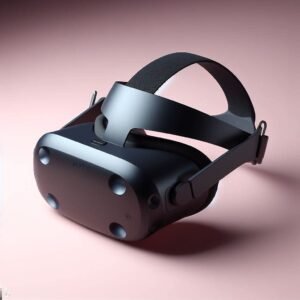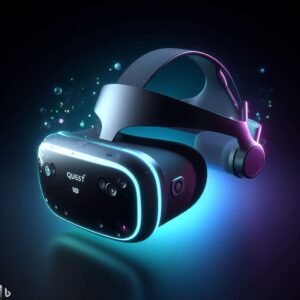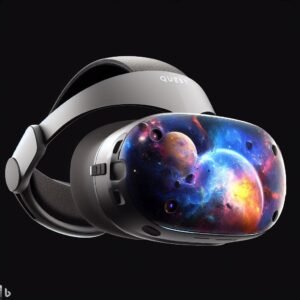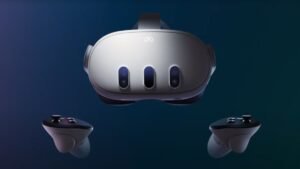Meta, formerly known as Facebook, has recently announced its latest , which promises to deliver a new level of immersion and interactivity with its mixed reality features. But what is mixed reality and how does it work on the Quest 3? In this article, we will explain what mixed reality is, how it differs from virtual reality and augmented reality, and what are the benefits and challenges of using it on the Quest 3.

What is Mixed Reality?
Mixed reality (MR) is a technology that seamlessly combines the real world with virtual elements, creating a new immersive experience. Unlike virtual reality (VR), which replaces the real world with a completely digital environment, or augmented reality (AR), which overlays digital information on top of the real world, mixed reality blends the two worlds together, allowing users to see and interact with both real and virtual objects at the same time.

For example, with mixed reality, you can see your own hands and body in VR, as well as the physical objects around you, such as your furniture, walls, or windows. You can also see and manipulate virtual objects that appear in your real space, such as a holographic character, a floating menu, or a 3D model. You can also move around freely in your real space and see the virtual objects adjust accordingly to your perspective and position.

How Does Mixed Reality Work on the Quest 3?
The Quest 3 is Meta’s newest VR headset that features mixed reality capabilities. It has two front-facing full-color cameras and a depth sensor that allow it to capture the real world in high resolution and display it inside the headset in real time. It also has advanced computer vision algorithms that enable it to track the user’s head, hands, eyes, and facial expressions, as well as the environment and objects around them.

The Quest 3 uses these technologies to create a realistic and interactive mixed reality experience for the user. It can detect the user’s physical boundaries and suggest a virtual boundary for safety. It can also recognize the user’s gestures and voice commands and use them to control the virtual elements. It can also generate realistic lighting and shadows for the virtual objects based on the real environment. It can also create spatial audio that matches the location and direction of the virtual sounds.

The Quest 3 also has a diverse category of VR games and apps that support mixed reality. Users can choose from different genres, such as action, adventure, puzzle, social, education, and more. Some examples of mixed reality games and apps on the Quest 3 are:
• Direct Touch: A feature that allows users to touch and interact with virtual objects using their own hands without controllers.
• Meta Horizon: A social VR platform that allows users to create, explore, and connect with others in various virtual worlds.
• Beat Saber: A rhythm game that lets users slash colorful blocks with virtual lightsabers while moving to music.
• Superhot VR: An action game that slows down time when users stop moving and speeds up when they move.
• Tilt Brush: A creative app that lets users paint in 3D space with various brushes and colors.

What are the Benefits and Challenges of Mixed Reality on the Quest 3?
Mixed reality on the Quest 3 offers many benefits for users who want to experience a new level of immersion and interactivity in VR. Some of these benefits are:
• Enhanced realism: Mixed reality makes VR more realistic by showing the user’s own body and surroundings in VR. This can increase the user’s sense of presence and embodiment in VR.
• Increased comfort: Mixed reality can reduce motion sickness and eye strain by providing visual cues from the real world that match the user’s movements and expectations in VR.
• Improved accessibility: Mixed reality can make VR more accessible by allowing users to use their own hands or voice instead of controllers or keyboards. This can make VR easier and more intuitive for users who have disabilities or limitations.
• Expanded possibilities: Mixed reality can expand the possibilities of VR by enabling users to create, explore, and interact with both real and virtual objects in new ways. This can open up new opportunities for entertainment, education, communication, and more.
However, mixed reality on the Quest 3 also faces some challenges that need to be addressed. Some of these challenges are:
• Privacy concerns: Mixed reality requires capturing and processing the user’s personal data, such as their face, voice, location, and behavior. This can raise privacy concerns for users who do not want their data to be collected or shared by Meta or third parties.
• Technical limitations: Mixed reality relies on complex technologies that are not perfect or reliable. For example, the cameras may not capture the real world accurately or clearly due to low light or occlusion. The tracking may not work well due to interference or occlusion. The rendering may not be fast or smooth due to limited processing power or bandwidth.
• Ethical issues: Mixed reality can create ethical issues by blurring the boundaries between reality and fiction. For example, users may not be able to distinguish between real and virtual objects or people. Users may also be influenced by the virtual elements in ways that affect their real behavior or decisions.

Conclusion
Mixed reality is a technology that combines the real world with virtual elements, creating a new immersive experience. The Quest 3 is Meta’s latest VR headset that features mixed reality capabilities. It uses cameras, sensors, and algorithms to capture and display the real world in VR, and to track and interact with the user and the environment. It also has a variety of VR games and apps that support mixed reality. Mixed reality on the Quest 3 offers many benefits for users who want to experience a new level of immersion and interactivity in VR, but it also faces some challenges that need to be addressed. Mixed reality on the Quest 3 is a promising and exciting technology that can bring VR to the next level.







